Dyson's sphere - what is it for? Part III: Application of the Dyson Ring and individual elements
Having examined in the first part of the article the history of the idea of the Dyson sphere and determining the simplest and most practical version of its design in the form of a non-rigid Dyson Ring, I devoted the second part of the article to a detailed analysis of the design of such a Ring from separate (moderately gigantic) autonomous elements. There, the construction of a rather primitive autonomous element of the Ring was described in detail, its approximate weight and the parameters of the entire Ring for two radii were calculated.
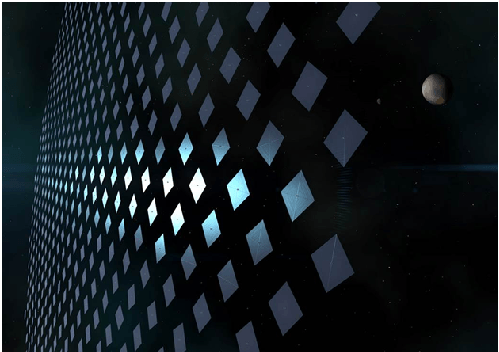
Now we can get to the point: Why can we use such a non-rigid Ring of separate autonomous elements?
Firstly, as already described above, each hexagonal (or octagonal) element of the Ring with a sealed central module is itself a base for energy production + or an autonomous colony for several hundreds or thousands of people (with food production), embodying Tsiolkovsky’s dreams about “ethereal cities”, or a mineral processing plant (energy-intensive production of materials) and / or a fuel generation station (in the form of an oxygen / hydrogen pair, plus other gases for different engines, enrichment from otopov for nuclear and thermonuclear reactions).
Secondly, each element of the Ring can change the tilt of its mirror to the direction to the Sun and redirect its “bunny” of reflected sunlight to where it is needed: to other elements, to the Earth, to a spacecraft or to an asteroid that needs to be illuminated, heated, evaporate, develop. This is energy, and weapons, and a signal - any of the list. Something similar is shown at the beginning (from 10 to 50 seconds) of this video
. Thirdly, the energy produced on the element can be redirected from the element: via cables - to neighboring elements of the ring, by laser or HF radio beams to receiving stations within the ring, or to asteroids or to spacecraft (in extreme cases, and directly to satellites and planets).
Fourth, all the improvements described above, as well as projects of the Ring modernization that are not yet accessible even to our imagination, will be carried out on the basis of the original Ring, using its capabilities and materials, and taking into account the invaluable experience of its construction.
Examples of the application of individual elements
1. Do you need to vaporize or move a satellite or an asteroid (comet) from orbit? One or several elements of the Ring are delivered to the desired point, which with their “bunnies” of reflected light (and with the addition of other radiation) heat this object for a long time and persistently.
Such objections often sound: the creation of a huge swarm of elements is supposedly the dispersal and squandering of the resources of the solar system. But apart from the working fluid spent on delivering the unfinished element and reserves to a stable orbit, nothing from the system disappears or disappears. All elements, if desired, can be redone into something else, to build on their basis something new and perfect. This is easier than extracting material from scratch. The following three examples of this:
2. Do you need to send a signal for light years to another system? Or get a weak signal from afar? Here the elements of the Ring come in handy: each element is already an antenna in itself, you can assemble several elements of the Ring into a parabolic or spherical antenna, deploy it in the right direction and add a radiating / receiving device to the focus.
3.Need to assemble a huge ark ship in order to reach (at a speed much slower than the speed of light) a neighboring star in hundreds of years? Elements of the Ring are easier to disassemble and recycle in place in the ship than to build a ship from scratch.
4. Need to assemble a huge ship with a solar sail? You can take one or more elements of the Ring and build from them something like a slow ship flying in the solar wind, in addition to the momentum of other engines.
5.Need to disperse a smaller ship using an external energy source? This can be done by directing laser or other rays (light, HF radio) from the elements of the Ring to the receiving antenna of the ship (the energy received there will then be directed to ion / plasma or other engines), or to a reflecting mirror (photon rocket) - photon traction.
Laser beam acceleration
The last term recently loudly sounded like the idea of the DEEP-IN project ( Directed Energy Propulsion for Interstellar Exploration ), promoted by Yuri Milner, Stephen Hawking and especially Philip Lyubin (it has been since 2013) in the next 30-50 years. https://arxiv.org/ftp/arxiv/papers/1604/1604.01356.pdf .
By the way, Robert Forward expressed a similar idea of interstellar travel back in 1984 (now his designs are called the traditional schemes of the solar sailboats Matloff and Forward ). The new idea of accelerating precisely ultra-small (weighing in grams) interstellar probes with thin and small (about 1 m in diameter) light sails with superpowerful ground-based and orbital (located in space) laser arrays caused a great resonance and serious discussion. In principle, when solving many technical problems, the main one being laser ablation of sail material, such a system can blast a mini-probe into interstellar space with speeds of course not 20%, but at least about 5% of the speed of light. The idea of the project is based onPhilip Lubin’s article “A Roadmap to Interstellar Flight” with a project plan , which the author sent to the scientific journal JBIS: Journal of the British Interplanetary Society in April 2015, and its most recent edition is dated September 2016 . By the way, in this presentation , on slide 44, Lubin addresses the idea of the Dyson sphere and the problems of finding such structures.
There are several huge objections to the feasibility of the project (almost immediately voiced by critics, for example, briefly and in the case here http://trv-science.ru/2016/04/19/dvojka-po-fizike/ - continued: http: // trv -science.ru/2016/05/17/pod-zvezdnym-parusom-k-alpha-centauri/) Thus, the DEEP-IN project states that arrays of lasers for such acceleration can be located in near-Earth orbits (to avoid absorption of the laser by the atmosphere, self-focusing of the beam) or even on Earth in a high and dry place (in a presentation video). And supposedly from there they will once and for all quickly quickly disperse the probe to the desired speed.
The problem is that you cannot accelerate such a mini-probe with a small sail too quickly - acceleration will break it, you cannot even lighten a thin sail with an excessively powerful laser beam - heating will melt the sail or pass it through during the ablation of the material from radiation. It is necessary to disperse the probe slowly and not too powerful laser.
However, when the probe accelerates slowly, another serious problem arises with the laser beam: since any laser has a divergence (divergence) of the beam, the beam diverges with distance. The beam divergence angle is usually equal to: θ = 1.22λ / d , where λ is the wavelength, d is the beam diameter (diameter of the laser outlet). The discrepancy for conventional (narrow aperture) lasers is about 1 arc minute. This means that the laser beam on the moon will already be about 2 km in diameter, and beyond the orbit of Mars it will be hundreds of kilometers! ( more details here ). The illumination of the mini-probe sail at such distances by such a weak, scattered beam will be almost useless for its acceleration - slow acceleration will break off beyond the orbit of the moon.
But the authors of the project have great hopes for phase-controlled arrays of small erbium (Yb) fiber lasers (efficiency up to 78%) with a phase control device. In some ways, the idea of such an array of lasers resembles the idea of a radar with an active phased antenna array: like elements of a phased antenna array, lasers must change the relative phases of their radiation in a complex way, so that it amplifies in one desired direction and is suppressed in all other directions(perfectly). An important positive detail for the feasibility of the project is the serious progress of such fiber lasers in recent years - progress in both power and compactness (a decrease in size is observed according to Moore's law) and in price. A field of 1 per 1 km size can accommodate about 20 million phase-matched small kilowatt Yb lasers weighing 25-30 kg with an efficiency of about 50% and with a short wavelength (in the region of 1 micron or 1060 nm) to get the output laser radiation of tens of gigawatts - the so-called DE-STAR 4 array. It is argued that the beam divergence angle for such an array will be equal to: θ = 1.22λ / d= 10 ^ -9 radians = 0.0002 arc seconds, since d here will be about 1000 m. However, it is the linear dimensions and mass of such a laser array that compel the authors of the project to choose ground placement, which leads to problems with the atmosphere in the path of the beam.
And the problem of pointing the laser at such a small and remote for millions of kilometers probe sail also remains.
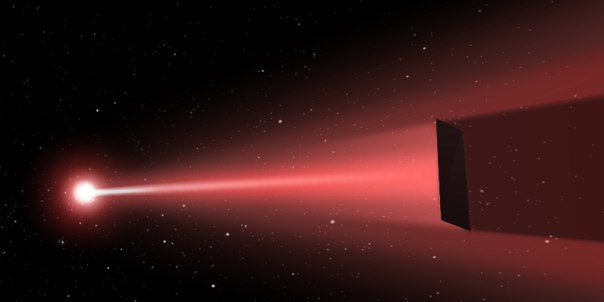
But you can disperse a minisonde first with an array of lasers from Earth’s orbit, then with another array near the Moon, then with a third one further away ... etc.
And the elements of the Ring (remaining in their orbits) can produce energy for such laser arrays, or be a platform for installing such lasers. To do this, they must be set in various orbits around the Earth, at Lagrange points, in orbits around the Sun, with a radius of just over 1 AU
The elements of the Ring can be sent to points in advance (for example, by conventional engines or by means of the solar wind and by means of illumination from other elements of the Ring) along the future flight path of such a probe from the Earth’s orbit and even to the very outskirts of the Solar System. There, with the energy accumulated in the batteries and / or in the fuel, the elements of the Ring will wait for the mini-probe to fly past them and illuminate it behind with moderately powerful laser beams within its part of the trajectory (0.3-0.5 million km long), then transmitting the probe to the following elements:
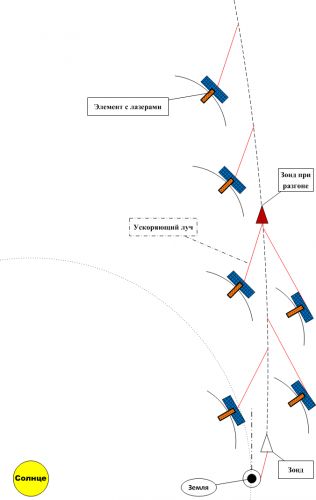
At the same time, they in turn give out energy by a beam to a mini-probe, accelerating it within the range of their beam, passing each other an accelerating ship, as if on a relay race.
Or a slightly more advanced option: not using the energy reserves in the batteries, but simply sending light / energy along the chain from one element to another, so that the current active element, taking this energy last, directs it to a minisonde accelerated outside our system:
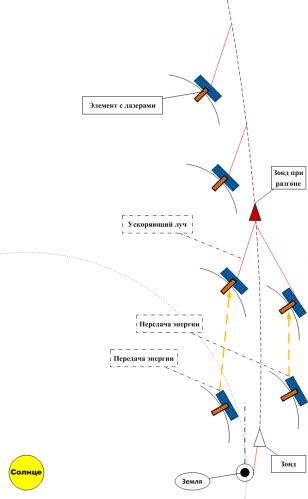
By the way, the elements Rings can accelerate not only such mini-probes for flights outside the system. Directly from its place in the Ring, an element can accelerate and slow down the intra-system cargo ships with solar sails when delivering goods from and to the elements of the Ring (of course we are not talking about high speeds). With this, you can begin the development of photon traction, improving the technique and methods for the slow acceleration and deceleration of ships inside the solar system. In this work of 2013the authors (including Philip Lubin) also discuss in detail such intrasystem flights with braking after the ship turns with the sail-mirror forward (ping-pong method).
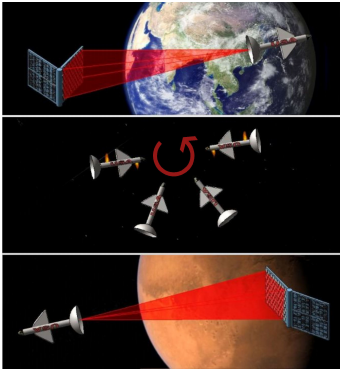
The problem with detecting the Ring from the outside
The moment associated with sending signals to the outside (example 2.above), arises at the assembly stage of such a Ring. Whether the creators of the Ring want it or not, but if the elements of the Ring are combined into segments with characteristic sizes of about 1 million km (the diameter of Jupiter, the largest planet in the solar system, is about 0.14 million km, which is 7 times smaller), then any outside observer , located approximately in the plane of the Ring, begins to register (regardless of the desire of the creators of the Ring) strange, unprecedented, periodic eclipses of the central luminary by an object that, by linear dimensions, obviously exceeds the sizes of giant planets. And the observer (there are much more such ones in the Galaxy) is not likely to notice anything in the plane of the Ring. This is an important point: a random observer has few chances to be in the right direction from such a star.
If in this system, at given distances from the luminary (with given periods), no giant celestial bodies such as red or brown dwarfs, black holes, cold (not emitting infrared background) thin dust-gas protoplanetary clouds were discovered (accessible here ) , then this is a serious reason for the observer to think about the artificial causes of this phenomenon.
As happened with the Earth’s astronomers, who recently with the help of the Kepler space telescope noticed periodic (once every 750 days) and short (about a day) luminosity reductions of 10-22% of an exceptionally stable star (ordinary spectral type F3 V / IV) under the number KIC 8462852 ( https://geektimes.ru/post/267022/ ). She isthe Tabby star , around which (according to observations) there are no other satellite stars (red dwarfs), there is no increased infrared or ultraviolet radiation, which means there are most likely no planetary nebula, no asteroid belts, or brown dwarf type satellites close to the star - it's easier speaking, there are no natural astronomical reasons that could explain such a vast eclipse of the central luminary. There were versions with comets, more precisely, exo-comets ( https://geektimes.ru/post/266408/ ), an asteroid belt, or a recent collision of exoplanets there.
It should be noted that the period of eclipses of 727 days does not correspond much to the periods of comet rotation characteristic of our system (not to mention the fact that the passage of comets near such a massive star as the Sun often leads to complete or partial decay of comets or to a strong change in their orbits). It is difficult to imagine such a huge (covering 1/5 disk of the star) and compact (covering only a day or a couple of days) swarm of comets, which with their cores or tails manages to close as much as 22% of the light of that star with such a strange period of 750 days. This has been discussed here .
Then a version was added (not yet discarded) with a special perspective of our observation of the planetary disk (clouds) with cold continuous outer layers located far around this star and blocking the infrared radiation of the inner layers ( https://geektimes.ru/post/280062/ ). This, so to speak, natural analogue of the man-made Ring described above sometimes overshadows a star by 15-20%. Suppose this is so, this may well be. But just how does this apparently very thin (but not bursting) disk manage to outshine a small star like this for only a day?
Recently there was a newsabout the result of the processing by two specialists from the USA (Valery Makarov from the US Navy Observatory in Washington and Alexey Goldin from the company Teza Technology) the raw data from the Kepler space telescope with two large eclipses of this star. Among other things, they checked the position of the star relative to other objects during eclipses. The results they obtained were very strange - they claim that at the time of the eclipse the star itself (more precisely, the "center of brightness" of light from it) shiftedrelative to the receiving matrix of the telescope! The conclusions so far are as follows: either some comets or planetoids (still large) block the “Tabby star”, but not in the orbit of this star, but in the orbit of some other massive body (black hole? Brown dwarf?), Closer to us (along the observation line), or some object of non-natural origin at KIC 8462852 itself is to blame.
The period of 727 days approximately corresponds to the orbit parameters in the habitable zone or outside the habitable zone for this star (it is about 1.5 larger than the Sun, its the luminosity is 4.7 times greater than the solar, so the period It must be clearly larger 400-500 days).
By the way, the analysis of Leonid Xanfomality from the Institute of Space Physics of the Russian Academy of Sciences revealed an unusual shape of the light curve (the curve below is taken fromof the original article and simply increased) for the two deepest dips / eclipses: The
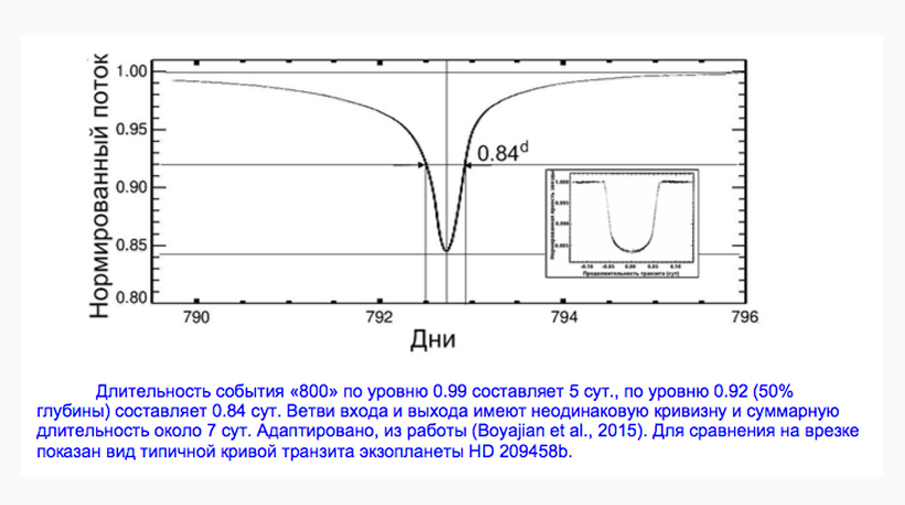
velocities of the first decay and then increase in the brightness of the star are asymmetrical, which may be evidence of the elongation of the orbits of the eclipsing bodies. Further, based on the shape of the curve and the duration of coverage, Xanfomality estimated the possible parameters of the orbit of the cosmic body causing the eclipse.
It would be useful for astronomers at the next eclipse (in 2017) to calculate the shape of the objects that overshadow it, using the exact graph of the fall and increase in the luminosity of the Tabby star, especially since there is such a technique: ( http://arxiv.org/abs/astro-ph/0503580 ) . There are also methods for determining the angle / direction of intersection of a star’s disk with an object such as a planet:
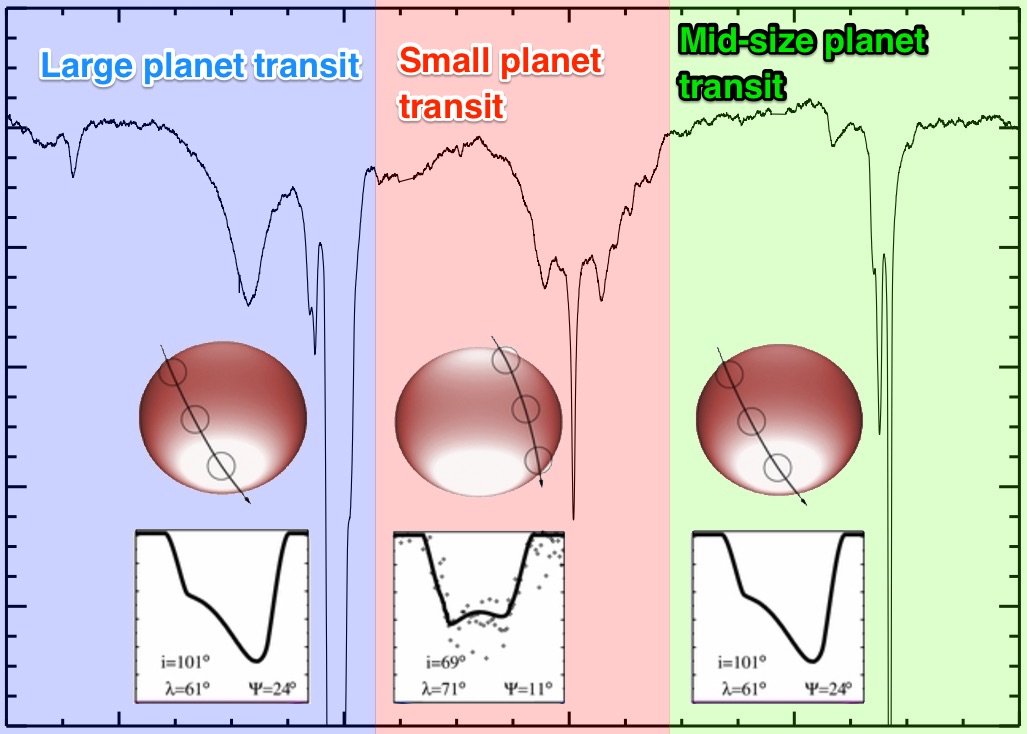
If the shape of these objects turns out to be not round, but for example square or triangular, then this is a clear indication of the artificial origin of the eclipsing objects.
By the way, the “small ripple” of the eclipses of the Tabby star basically suits the effect of the unfinished elements of the swarm obscuring the light of this star, and large eclipses once every 750 days can be caused by super-elements of the swarm already built up to gigantic dimensions (or by the union of many small elements).
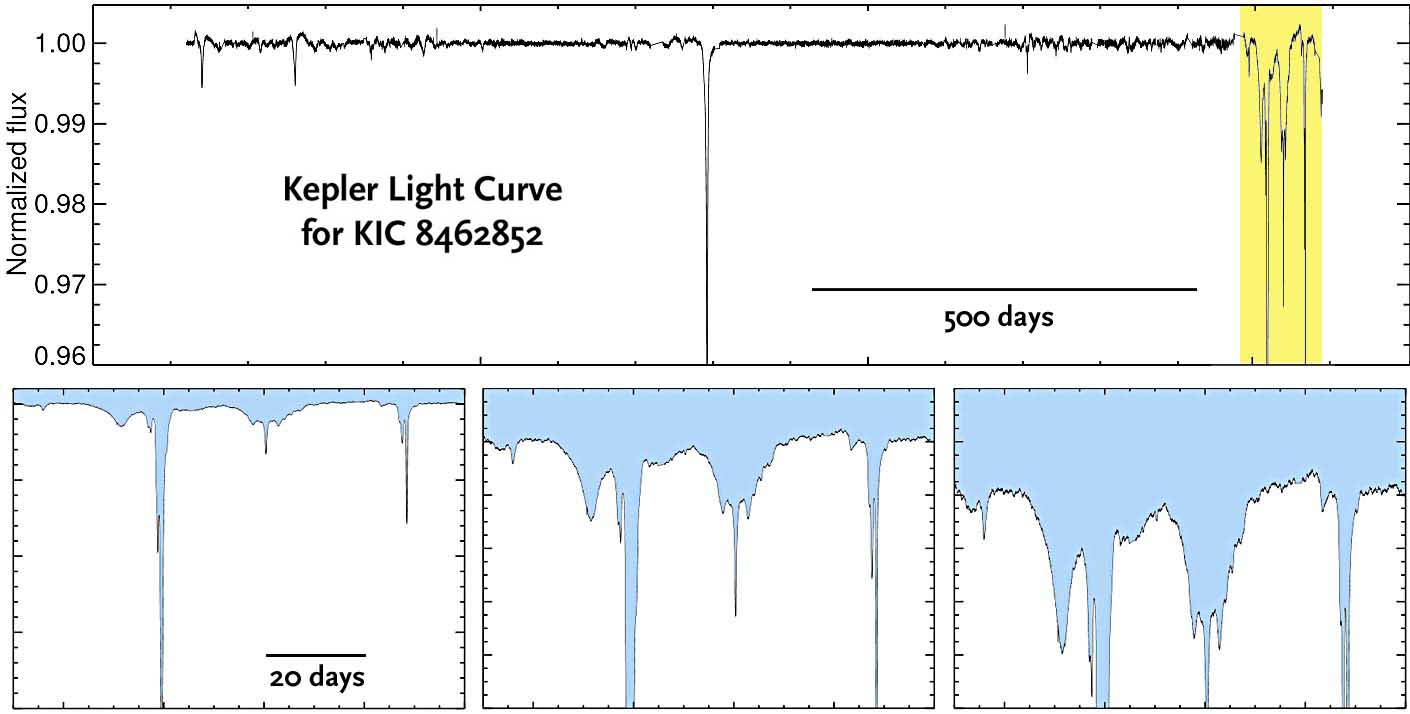
Conclusions:
The arguments presented above in this article suggest that any advanced civilization of a technical type, with the desire and will to expand its presence in space using space resources, is likely to build some kind of discontinuous Dyson type I sphere (in the form of Roy Dyson) , applying it not so much to increase places suitable for living (although you can somehow live on such elements), but for two main purposes:
In addition, such a civilization will receive two or three other pleasant bonuses:

I hope that the above arguments for building not the Dyson sphere, but rather Roy in the form of the Dyson Ring, were quite convincing. I would like to believe that with the development of real development (and not study, as they say now) of our solar system, sometime these or similar arguments will convince our descendants to build just such a version of the Dyson sphere in the form of a non-rigid Ring. I am sure that more advanced civilizations in our Galaxy were already convinced by such arguments many millennia ago and are now simply busy with a business that stretched out over many millennia, which they undoubtedly were ready for from the very beginning of construction.

Now we can get to the point: Why can we use such a non-rigid Ring of separate autonomous elements?
Firstly, as already described above, each hexagonal (or octagonal) element of the Ring with a sealed central module is itself a base for energy production + or an autonomous colony for several hundreds or thousands of people (with food production), embodying Tsiolkovsky’s dreams about “ethereal cities”, or a mineral processing plant (energy-intensive production of materials) and / or a fuel generation station (in the form of an oxygen / hydrogen pair, plus other gases for different engines, enrichment from otopov for nuclear and thermonuclear reactions).
Secondly, each element of the Ring can change the tilt of its mirror to the direction to the Sun and redirect its “bunny” of reflected sunlight to where it is needed: to other elements, to the Earth, to a spacecraft or to an asteroid that needs to be illuminated, heated, evaporate, develop. This is energy, and weapons, and a signal - any of the list. Something similar is shown at the beginning (from 10 to 50 seconds) of this video
. Thirdly, the energy produced on the element can be redirected from the element: via cables - to neighboring elements of the ring, by laser or HF radio beams to receiving stations within the ring, or to asteroids or to spacecraft (in extreme cases, and directly to satellites and planets).
Fourth, all the improvements described above, as well as projects of the Ring modernization that are not yet accessible even to our imagination, will be carried out on the basis of the original Ring, using its capabilities and materials, and taking into account the invaluable experience of its construction.
Examples of the application of individual elements
1. Do you need to vaporize or move a satellite or an asteroid (comet) from orbit? One or several elements of the Ring are delivered to the desired point, which with their “bunnies” of reflected light (and with the addition of other radiation) heat this object for a long time and persistently.
Such objections often sound: the creation of a huge swarm of elements is supposedly the dispersal and squandering of the resources of the solar system. But apart from the working fluid spent on delivering the unfinished element and reserves to a stable orbit, nothing from the system disappears or disappears. All elements, if desired, can be redone into something else, to build on their basis something new and perfect. This is easier than extracting material from scratch. The following three examples of this:
2. Do you need to send a signal for light years to another system? Or get a weak signal from afar? Here the elements of the Ring come in handy: each element is already an antenna in itself, you can assemble several elements of the Ring into a parabolic or spherical antenna, deploy it in the right direction and add a radiating / receiving device to the focus.
3.Need to assemble a huge ark ship in order to reach (at a speed much slower than the speed of light) a neighboring star in hundreds of years? Elements of the Ring are easier to disassemble and recycle in place in the ship than to build a ship from scratch.
4. Need to assemble a huge ship with a solar sail? You can take one or more elements of the Ring and build from them something like a slow ship flying in the solar wind, in addition to the momentum of other engines.
5.Need to disperse a smaller ship using an external energy source? This can be done by directing laser or other rays (light, HF radio) from the elements of the Ring to the receiving antenna of the ship (the energy received there will then be directed to ion / plasma or other engines), or to a reflecting mirror (photon rocket) - photon traction.
Laser beam acceleration
The last term recently loudly sounded like the idea of the DEEP-IN project ( Directed Energy Propulsion for Interstellar Exploration ), promoted by Yuri Milner, Stephen Hawking and especially Philip Lyubin (it has been since 2013) in the next 30-50 years. https://arxiv.org/ftp/arxiv/papers/1604/1604.01356.pdf .
By the way, Robert Forward expressed a similar idea of interstellar travel back in 1984 (now his designs are called the traditional schemes of the solar sailboats Matloff and Forward ). The new idea of accelerating precisely ultra-small (weighing in grams) interstellar probes with thin and small (about 1 m in diameter) light sails with superpowerful ground-based and orbital (located in space) laser arrays caused a great resonance and serious discussion. In principle, when solving many technical problems, the main one being laser ablation of sail material, such a system can blast a mini-probe into interstellar space with speeds of course not 20%, but at least about 5% of the speed of light. The idea of the project is based onPhilip Lubin’s article “A Roadmap to Interstellar Flight” with a project plan , which the author sent to the scientific journal JBIS: Journal of the British Interplanetary Society in April 2015, and its most recent edition is dated September 2016 . By the way, in this presentation , on slide 44, Lubin addresses the idea of the Dyson sphere and the problems of finding such structures.
There are several huge objections to the feasibility of the project (almost immediately voiced by critics, for example, briefly and in the case here http://trv-science.ru/2016/04/19/dvojka-po-fizike/ - continued: http: // trv -science.ru/2016/05/17/pod-zvezdnym-parusom-k-alpha-centauri/) Thus, the DEEP-IN project states that arrays of lasers for such acceleration can be located in near-Earth orbits (to avoid absorption of the laser by the atmosphere, self-focusing of the beam) or even on Earth in a high and dry place (in a presentation video). And supposedly from there they will once and for all quickly quickly disperse the probe to the desired speed.
The problem is that you cannot accelerate such a mini-probe with a small sail too quickly - acceleration will break it, you cannot even lighten a thin sail with an excessively powerful laser beam - heating will melt the sail or pass it through during the ablation of the material from radiation. It is necessary to disperse the probe slowly and not too powerful laser.
However, when the probe accelerates slowly, another serious problem arises with the laser beam: since any laser has a divergence (divergence) of the beam, the beam diverges with distance. The beam divergence angle is usually equal to: θ = 1.22λ / d , where λ is the wavelength, d is the beam diameter (diameter of the laser outlet). The discrepancy for conventional (narrow aperture) lasers is about 1 arc minute. This means that the laser beam on the moon will already be about 2 km in diameter, and beyond the orbit of Mars it will be hundreds of kilometers! ( more details here ). The illumination of the mini-probe sail at such distances by such a weak, scattered beam will be almost useless for its acceleration - slow acceleration will break off beyond the orbit of the moon.
But the authors of the project have great hopes for phase-controlled arrays of small erbium (Yb) fiber lasers (efficiency up to 78%) with a phase control device. In some ways, the idea of such an array of lasers resembles the idea of a radar with an active phased antenna array: like elements of a phased antenna array, lasers must change the relative phases of their radiation in a complex way, so that it amplifies in one desired direction and is suppressed in all other directions(perfectly). An important positive detail for the feasibility of the project is the serious progress of such fiber lasers in recent years - progress in both power and compactness (a decrease in size is observed according to Moore's law) and in price. A field of 1 per 1 km size can accommodate about 20 million phase-matched small kilowatt Yb lasers weighing 25-30 kg with an efficiency of about 50% and with a short wavelength (in the region of 1 micron or 1060 nm) to get the output laser radiation of tens of gigawatts - the so-called DE-STAR 4 array. It is argued that the beam divergence angle for such an array will be equal to: θ = 1.22λ / d= 10 ^ -9 radians = 0.0002 arc seconds, since d here will be about 1000 m. However, it is the linear dimensions and mass of such a laser array that compel the authors of the project to choose ground placement, which leads to problems with the atmosphere in the path of the beam.
And the problem of pointing the laser at such a small and remote for millions of kilometers probe sail also remains.

But you can disperse a minisonde first with an array of lasers from Earth’s orbit, then with another array near the Moon, then with a third one further away ... etc.
And the elements of the Ring (remaining in their orbits) can produce energy for such laser arrays, or be a platform for installing such lasers. To do this, they must be set in various orbits around the Earth, at Lagrange points, in orbits around the Sun, with a radius of just over 1 AU
The elements of the Ring can be sent to points in advance (for example, by conventional engines or by means of the solar wind and by means of illumination from other elements of the Ring) along the future flight path of such a probe from the Earth’s orbit and even to the very outskirts of the Solar System. There, with the energy accumulated in the batteries and / or in the fuel, the elements of the Ring will wait for the mini-probe to fly past them and illuminate it behind with moderately powerful laser beams within its part of the trajectory (0.3-0.5 million km long), then transmitting the probe to the following elements:

At the same time, they in turn give out energy by a beam to a mini-probe, accelerating it within the range of their beam, passing each other an accelerating ship, as if on a relay race.
Or a slightly more advanced option: not using the energy reserves in the batteries, but simply sending light / energy along the chain from one element to another, so that the current active element, taking this energy last, directs it to a minisonde accelerated outside our system:

By the way, the elements Rings can accelerate not only such mini-probes for flights outside the system. Directly from its place in the Ring, an element can accelerate and slow down the intra-system cargo ships with solar sails when delivering goods from and to the elements of the Ring (of course we are not talking about high speeds). With this, you can begin the development of photon traction, improving the technique and methods for the slow acceleration and deceleration of ships inside the solar system. In this work of 2013the authors (including Philip Lubin) also discuss in detail such intrasystem flights with braking after the ship turns with the sail-mirror forward (ping-pong method).

The problem with detecting the Ring from the outside
The moment associated with sending signals to the outside (example 2.above), arises at the assembly stage of such a Ring. Whether the creators of the Ring want it or not, but if the elements of the Ring are combined into segments with characteristic sizes of about 1 million km (the diameter of Jupiter, the largest planet in the solar system, is about 0.14 million km, which is 7 times smaller), then any outside observer , located approximately in the plane of the Ring, begins to register (regardless of the desire of the creators of the Ring) strange, unprecedented, periodic eclipses of the central luminary by an object that, by linear dimensions, obviously exceeds the sizes of giant planets. And the observer (there are much more such ones in the Galaxy) is not likely to notice anything in the plane of the Ring. This is an important point: a random observer has few chances to be in the right direction from such a star.
If in this system, at given distances from the luminary (with given periods), no giant celestial bodies such as red or brown dwarfs, black holes, cold (not emitting infrared background) thin dust-gas protoplanetary clouds were discovered (accessible here ) , then this is a serious reason for the observer to think about the artificial causes of this phenomenon.
As happened with the Earth’s astronomers, who recently with the help of the Kepler space telescope noticed periodic (once every 750 days) and short (about a day) luminosity reductions of 10-22% of an exceptionally stable star (ordinary spectral type F3 V / IV) under the number KIC 8462852 ( https://geektimes.ru/post/267022/ ). She isthe Tabby star , around which (according to observations) there are no other satellite stars (red dwarfs), there is no increased infrared or ultraviolet radiation, which means there are most likely no planetary nebula, no asteroid belts, or brown dwarf type satellites close to the star - it's easier speaking, there are no natural astronomical reasons that could explain such a vast eclipse of the central luminary. There were versions with comets, more precisely, exo-comets ( https://geektimes.ru/post/266408/ ), an asteroid belt, or a recent collision of exoplanets there.
It should be noted that the period of eclipses of 727 days does not correspond much to the periods of comet rotation characteristic of our system (not to mention the fact that the passage of comets near such a massive star as the Sun often leads to complete or partial decay of comets or to a strong change in their orbits). It is difficult to imagine such a huge (covering 1/5 disk of the star) and compact (covering only a day or a couple of days) swarm of comets, which with their cores or tails manages to close as much as 22% of the light of that star with such a strange period of 750 days. This has been discussed here .
Then a version was added (not yet discarded) with a special perspective of our observation of the planetary disk (clouds) with cold continuous outer layers located far around this star and blocking the infrared radiation of the inner layers ( https://geektimes.ru/post/280062/ ). This, so to speak, natural analogue of the man-made Ring described above sometimes overshadows a star by 15-20%. Suppose this is so, this may well be. But just how does this apparently very thin (but not bursting) disk manage to outshine a small star like this for only a day?
Recently there was a newsabout the result of the processing by two specialists from the USA (Valery Makarov from the US Navy Observatory in Washington and Alexey Goldin from the company Teza Technology) the raw data from the Kepler space telescope with two large eclipses of this star. Among other things, they checked the position of the star relative to other objects during eclipses. The results they obtained were very strange - they claim that at the time of the eclipse the star itself (more precisely, the "center of brightness" of light from it) shiftedrelative to the receiving matrix of the telescope! The conclusions so far are as follows: either some comets or planetoids (still large) block the “Tabby star”, but not in the orbit of this star, but in the orbit of some other massive body (black hole? Brown dwarf?), Closer to us (along the observation line), or some object of non-natural origin at KIC 8462852 itself is to blame.
The period of 727 days approximately corresponds to the orbit parameters in the habitable zone or outside the habitable zone for this star (it is about 1.5 larger than the Sun, its the luminosity is 4.7 times greater than the solar, so the period It must be clearly larger 400-500 days).
By the way, the analysis of Leonid Xanfomality from the Institute of Space Physics of the Russian Academy of Sciences revealed an unusual shape of the light curve (the curve below is taken fromof the original article and simply increased) for the two deepest dips / eclipses: The

velocities of the first decay and then increase in the brightness of the star are asymmetrical, which may be evidence of the elongation of the orbits of the eclipsing bodies. Further, based on the shape of the curve and the duration of coverage, Xanfomality estimated the possible parameters of the orbit of the cosmic body causing the eclipse.
From his estimates it follows that the body rotates in an elongated orbit with a pericenter of 3.83 astronomical units and a period of revolution of 6.26 years. However, the author himself notes the contradictions in his estimates, noting that with such a distant pericenter (in the solar system it would be located behind the asteroid belt), the projection of the orbit from any angle would look like an almost straight line and no asymmetry of the light drop curves would be observed.
It would be useful for astronomers at the next eclipse (in 2017) to calculate the shape of the objects that overshadow it, using the exact graph of the fall and increase in the luminosity of the Tabby star, especially since there is such a technique: ( http://arxiv.org/abs/astro-ph/0503580 ) . There are also methods for determining the angle / direction of intersection of a star’s disk with an object such as a planet:

If the shape of these objects turns out to be not round, but for example square or triangular, then this is a clear indication of the artificial origin of the eclipsing objects.
By the way, the “small ripple” of the eclipses of the Tabby star basically suits the effect of the unfinished elements of the swarm obscuring the light of this star, and large eclipses once every 750 days can be caused by super-elements of the swarm already built up to gigantic dimensions (or by the union of many small elements).

Conclusions:
The arguments presented above in this article suggest that any advanced civilization of a technical type, with the desire and will to expand its presence in space using space resources, is likely to build some kind of discontinuous Dyson type I sphere (in the form of Roy Dyson) , applying it not so much to increase places suitable for living (although you can somehow live on such elements), but for two main purposes:
- control the illumination (and hence the climate) of his native planet, as well as other mastered planets, asteroids;
- receiving enormous energy from the light of his star, using it locally or with transfer throughout its system.
In addition, such a civilization will receive two or three other pleasant bonuses:
- the generated energy and the reflected light of the star can be used as a weapon and as a way to remove comets and asteroids from the orbits;
- Ring elements can be used to signal outside the system;
- the generated energy can be used to power the acceleration and braking lasers of ships with photonic sails inside its system, which leads to the development of the technique of launching interstellar nano and mini-probes by the method of successive acceleration of the probe with relay transmission between elements of the Ring with lasers pre-set along the acceleration path ;
- completed and under construction elements of the Ring can be converted into other objects and devices necessary for space exploration.

I hope that the above arguments for building not the Dyson sphere, but rather Roy in the form of the Dyson Ring, were quite convincing. I would like to believe that with the development of real development (and not study, as they say now) of our solar system, sometime these or similar arguments will convince our descendants to build just such a version of the Dyson sphere in the form of a non-rigid Ring. I am sure that more advanced civilizations in our Galaxy were already convinced by such arguments many millennia ago and are now simply busy with a business that stretched out over many millennia, which they undoubtedly were ready for from the very beginning of construction.
